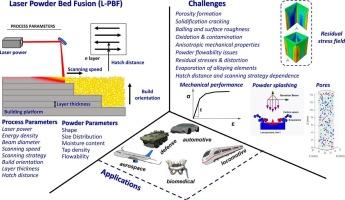Comprehensive review of fabrication process parameters influencing defect formation in laser powder bed fused (L-PBF) Al-Si alloys
IF 7.9
2区 材料科学
Q1 MATERIALS SCIENCE, MULTIDISCIPLINARY
引用次数: 0
Abstract
Recently, Laser Powder Bed Fusion (L-PBF) has garnered considerable interest for its ability to fabricate highly precise and intricate Al-Si alloy components. Its versatility in design makes it particularly appealing for industries such as aerospace and automotive, where lightweight structures are critical. However, the L-PBF process induces defects in the resulting components, such as solidification cracks, porosity, anisotropy, and uneven surfaces, which compromise structural integrity and dimensional accuracy. As a result, significant effort has been devoted to understanding how fabrication parameters influence defect formation in L-PBF Al-Si parts. Despite extensive research on laser material processing, a comprehensive understanding of how specific process parameters affect defect formation remains limited. This knowledge is crucial for optimizing the performance of L-PBF Al-Si components. This article aims to provide a systematic examination of the causes of defects in L-PBF Al-Si components and their relationship with fabrication factors and process parameters. Additionally, it offers insights into addressing these challenges and highlights future research directions to mitigate defects in L-PBF Al-Si components. Consequently, this work aims to further promote the development of L-PBF-manufactured Al-Si components and their widespread applications across diverse industries.

影响激光粉末床熔合Al-Si合金缺陷形成的工艺参数综述
最近,激光粉末床熔合(L-PBF)因其制造高精度和复杂的铝硅合金部件的能力而获得了相当大的兴趣。其设计的多功能性使其对航空航天和汽车等行业特别有吸引力,这些行业的轻量化结构至关重要。然而,L-PBF工艺会在生成的部件中产生缺陷,如凝固裂纹、孔隙、各向异性和表面不均匀,从而影响结构完整性和尺寸精度。因此,人们一直致力于了解制造参数如何影响L-PBF Al-Si部件中的缺陷形成。尽管对激光材料加工进行了广泛的研究,但对具体工艺参数如何影响缺陷形成的全面理解仍然有限。这些知识对于优化L-PBF Al-Si元件的性能至关重要。本文的目的是提供一个系统的检查缺陷的原因,在L-PBF铝硅元件及其与制造因素和工艺参数的关系。此外,它提供了解决这些挑战的见解,并强调了未来的研究方向,以减轻L-PBF Al-Si组件的缺陷。因此,这项工作旨在进一步促进l- pbf制造的Al-Si组件的发展及其在不同行业的广泛应用。
本文章由计算机程序翻译,如有差异,请以英文原文为准。
求助全文
约1分钟内获得全文
求助全文
来源期刊

Materials & Design
Engineering-Mechanical Engineering
CiteScore
14.30
自引率
7.10%
发文量
1028
审稿时长
85 days
期刊介绍:
Materials and Design is a multi-disciplinary journal that publishes original research reports, review articles, and express communications. The journal focuses on studying the structure and properties of inorganic and organic materials, advancements in synthesis, processing, characterization, and testing, the design of materials and engineering systems, and their applications in technology. It aims to bring together various aspects of materials science, engineering, physics, and chemistry.
The journal explores themes ranging from materials to design and aims to reveal the connections between natural and artificial materials, as well as experiment and modeling. Manuscripts submitted to Materials and Design should contain elements of discovery and surprise, as they often contribute new insights into the architecture and function of matter.
 求助内容:
求助内容: 应助结果提醒方式:
应助结果提醒方式:


